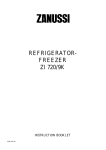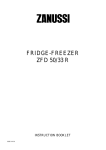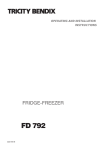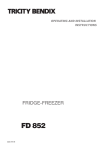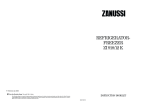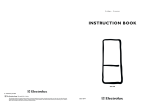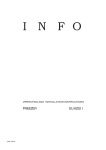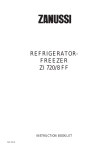Download Zanussi ZI 718/12 K Specifications
Transcript
REFRIGERATORFREEZER ZI 718/12 K INSTRUCTION BOOKLET 2222 032-61 WARNINGS GB IT IS MOST IMPORTANT THAT THIS INSTRUCTION BOOK SHOULD BE RETAINED WITH THE APPLIANCE FOR FUTURE REFERENCE. SHOULD THE APPLIANCE BE SOLD OR TRANSFERRED TO ANOTHER OWNER, OR SHOULD YOU MOVE HOUSE AND LEAVE THE APPLIANCE, ALWAYS ENSURE THAT THE BOOK IS SUPPLIED WITH THE APPLIANCE IN ORDER THAT THE NEW OWNER CAN GET TO KNOW THE FUNCTIONING OF THE APPLIANCE AND THE RELEVANT WARNINGS. THESE WARNINGS ARE PROVIDED IN THE INTEREST OF SAFETY. YOU MUST READ THEM CAREFULLY BEFORE INSTALLING OR USING THE APPLIANCE. General Safety ■ ■ ■ ■ ■ ■ This appliance is designed to be operated by adults. Children should not be allowed to tamper with the controls or play with the product. It is dangerous to alter the specifications or modify this product in any way. Care must be taken to ensure that the appliance does not stand on the electrical supply cable. Before defrosting, cleaning or maintenance work is carried out, be sure to switch off the appliance and unplug it. Do not remove items from the freezer if your hands are damp/wet, as this could cause skin abrasions or “frost/freezer burns”. Ice lollies can cause “frost/freezer burns” if consumed straight from the freezer. ■ Installation ■ ■ Service / Repair ■ ■ ■ Any electrical work required to install this appliance should be carried out by a qualified electrician or competent person. This product should be serviced by an authorised ZANUSSI Service Centre, and only genuine spare parts should be used. Under no circumstances should you attempt to repair the appliance yourself. Repairs carried out by inexperienced persons may cause injury or serious malfunctioning. Refer to your local ZANUSSI Service Centre and always insist on genuine spare parts. Use ■ ■ ■ ■ 2 ZANUSSI domestic refrigerators, freezers and fridge/freezers are designed to be used specifically for the storage of edible foodstuffs only. Frozen food must NOT be re-frozen once it has thawed out. Do not place carbonated or fizzy drinks in the freezer as it creates pressure on the container, which may cause it to explode, resulting in damage to the appliance. The cooling plate or refrigerated freezer shelves in this appliance contain channels through which the refrigerant passes. If these are punctured this would cause substantial damage to the appliance and result in food loss. DO NOT USE SHARP INSTRUMENTS to scrape off frost or ice. Under NO circumstances should solid ice be forced off the lining or shelves. Solid ice should be allowed to thaw, when defrosting the appliance. See Defrost instructions. Manufacturers’ storage recommendations should be strictly adhered to. Refer to relevant instructions. ■ ■ There are working parts in this product which heat up. Always ensure that there is adequate ventilation as a failure to do this will result in possible food loss. See installation instructions. Parts which heat up should not be exposed. Wherever possible, the back of the appliance should be close to a wall but leaving the required distance for ventilation as stated in the installation instructions. The appliance should be left for 2 hours after installation before it is turned on in order to allow the refrigerant to settle. This appliance is heavy. Care should be taken when moving it. Environment Protection This appliance does not contain gasses which could damage the ozone layer, in either its refrigerant circuit or insulation materials. The appliance shall not be discarded together with the urban refuse and rubbish. Avoid damaging the cooling unit, especially at the rear near the heat exchanger. Information on your local disposal sites may be obtained from your municipal authorities. The materials used on this appliance marked with the symbol are recyclable. When disposing of your old fridge, freezer or fridge/freezer. Help to keep your country tidy - use authorised disposal sites for your old appliances. ■ For maximum efficiency: Make sure that the appliance is cleaned properly. Make sure that the door is closed properly. Do not position the appliance near to sources of heat. Do not over-fill your appliance, air MUST be allowed to circulate. CONTENTS Description of the appliance Installation ■ Positioning ■ Before using ■ Instructions for totally built-in appliances ■ Door reversibility ■ Electrical connection 4 5 5 5 6 6 9 Health and safety guidelines ■ Fresh food refrigeration ■ Movable shelves ■ Positioning the door shelves ■ Cool check temperature guide ■ Starting the appliance ■ Everyday use of the cool check temperature guide ■ Technical specification Defrosting ■ Setting the temperature ■ The freezer compartment ■ ■ Freezing fresh food Thawing ■ Making ice cubes 13 13 13 14 14 14 15 10 Maintenance and cleaning Operation 12 16 11 11 11 11 11 11 ■ Internal cleaning ■ When the appliance is not in use ■ Changing the light bulb 16 16 16 What happens if something goes wrong ? 17 Guarantee conditions 18 2222 032-61 3 DESCRIPTION OF THE APPLIANCE GB A B L C K D J I H E 3 6 FAST FREEZE 9 12 G ABCDEFGHIJKL- 4 Thermostat control for fridge abd freezer compartments Dairy compartment Can storage shelf with egg tray Can storage shelf Bottle shelf Freezer calender (recommanded storage times for frozen foods) Storing frozen food Freezing fresh food Salad drawers Glass shelf Cool check temperature guide Glass shelves F INSTALLATION GB Before using Warning IF YOU ARE DISCARDING AN OLD APPLIANCE THAT HAS A LOCK OR CATCH ON THE DOOR, YOU MUST ENSURE THAT IT IS MADE UNUSABLE TO PREVENT YOUNG CHILDREN BEING TRAPPED INSIDE. Remove all securing tapes. Wash inside the appliance with lukewarm water and bicarbonate of soda (5 ml to 0.5 Iitre of water). Do not use soap or detergent as the smell may linger. Dry thoroughly. Positioning This appliance is designed to operate in ambient temperatures between 10°C (50°F) and 32°C (90°F). It should be located in a dry atmosphere, out of direct sunlight and away from extreme temperature e.g. not next to a cooker or other sources of direct heat, or in a very cold room e.g. an outhouse, where the temperatures may fall below 10°C (50°F). If these temperatures are exceeded i.e. colder or warmer, then the appliance may not operate correctly. For building-in and door reversibility, if necessary , refer to the relevant instructions in the following pages. 5 Instructions for totally built-in appliances Door reversibility (Fig. 1) P P A P1 P1 D114 Fig. 1 Right-hand opening Fig. 2 50 mm Left-hand opening min. 200 cm 2 Remove pins (P) and (P1) . Remove (P) from both sides and also remove the door . Remove centre hinge (A) and refit it on the opposite side. Refit the door and (P) on the left-hand side and remove (P1) from the right-hand side. min. cm 200 2 Recess dimensions D567 Hight Depth Width 1780 mm 550 mm 560 mm 540 50 To ensure adequate ventilation, allow the clearances shown in figure 2. B Furthermore, it is necessary that the niche is provid with a conduct of ventilation having the following dimensions: T depth width 50 mm 540 mm PR01 6 Fig. 3 H Push appliance into housing until stop strip (A) touches the kitchen unit. Fig. 4 A D023 Open the door and push the appliance against the side of the kitchen unit opposite to that of appliance hinges. Fasten the appliance with 4 screws provided in the kit included with the appliance. Snap ventgrille (C) and hinge cover (D) into position . Fig. 5 D D723 C Fig. 6 Press in the joint covers between the appliance and the kitchen unit. D724 Fig. 7 Apply covers (B) on joint cover lugs and into hinge holes. B D726 7 Position the runners (A) at the top and bottom of the inside of the kitchen unit as shown in Fig. 8 and mark the position of the external holes. After preparing the holes, screw the runners to the kitchen unit door using 3.5x16 mm screws. Fig. 8 A 20m m PR33 Open both the appliance door and that of the kitchen unit to approx. 90°. Place the little plates over the runners. Hold the doors of the appliance and the unit together and mark the holes. Fig. 9 8mm PR34 Remove the little plates and make the holes with a diam. of 2 mm. Replace the little plates over the runners and screw in the screws provided (3.5x16 mm). For the alignment of the kitchen unit door, if necessary, use the clearance size of the slotted holes. At the end of the procedure, check that the doors of the appliance and the kitchen unit open properly. Fig. 10 PR35 If the appliance is fixed to the side of the kitchen unit, simply slacken the screws in fixing brackets (D), move the brackets as shown in the figure and re-tighten the screws. Then fit cover (E). Fig. 11 D E D734 8 The electrical connections WARNING: THIS APPLIANCE MUST BE EARTHED. The manufacturer declines any liability should this safety measure not be observed. If the plug that is fitted to your appliance is not suitable for your socket outlet, it must be cut off and the appropriate plug fitted. Remove the fuse from the cut off plug. The cut off plug should then be disposed of to prevent the hazard of shocks in case it should be plugged into a 13amp socket in another part of your home. The plug must not be used if the fuse cover/carrier is lost. The cover/carrier is indicated by the coloured insert at the base of the plug. A replacement cover/carrier must be obtained from your local Zanussi Service Force Centre whose address is listed in the Customer Care Booklet which accompanies your instruction manual. This appliance complies with the E.E.C. Directive No. 87/308 of 2.6.87 relative to radio interference suppression. This appliance complies with the following E.E.C. Directives: Important The wires in the mains lead are coloured in accordance with the following code: Green and Yellow Blue Brown - Earth - Neutral - Live Please ensure that when the appliance is installed it is easily accessible for the engineer in the event of a breakdown. Fig.12 13 AMP 13 AMP. FUSE - 73/23 EEC of 19.2.73 (Low Voltage Directive) and subsequent modifications; - 89/336 EEC of 3.5.89 (Electromagnetic Compatibility Directive) and subsequent modifications. If you fit your own plug, the colours of the wires in the mains lead of your appliance may not correspond with the markings identifying the terminals in your plug, proceed as follows: GREEN & YELLOW fuse. For replacement, use a 13amp BSI362 fuse. Only ASTA or BSI approved fuses should be used. BROWN BLUE D207 CORD CLAMP Connect the Green and Yellow (earth) wire to the terminal in the plug which is marked with the letter «E» or the earth symbol or coloured green and yellow. Connect the blue (neutral) wire to the terminal in the plug which is marked with the letter «N» or coloured black. Connect the brown (live) wire to the terminal in the plug which is marked with the letter «L» or coloured red. The plug moulded onto the lead incorporates a 9 TECHNICAL SPECIFICATIONS POWER SUPPLY VOLTAGE AND FREQUENCY 220-240 V / 50 Hz TOTAL POWER ABSORBED 190 W AVERAGE DAILY UNITS ELECTRICITY * 1,35 kWh GROSS CAPACITY Fridge Freezer 173 l 110 l Fridge Freezer 170 l 92 l NET CAPACITY STAR RATING * This figure is based on standard test results in accordance with European Standard EN 153. Actual consumption will depend on how the appliance is used and where it is located . 10 GB OPERATION Setting the temperature GB The freezer compartment The temperature inside the refrigerator and freezer is regulated by a single thermostat with 6 temperature positions and one «OFF» (O) position. Position 1 = minimum cold Position 6 = maximum cold Turn the thermostat dial to the required position; the intermediate position is usually the most suitable. The thermostat setting can vary as the temperature inside the refrigerator compartment depends on the following factors: - room temperature - how often the door is opened - how much food is stored - position of the appliance Important If the refrigerator is not defrosting correctly, it is possible that because a very low temperature has been selected and the motor is working continuously, which prevents the defrost cycle from operating. To ensure correct defrosting, a lower number should be selected on the thermostat and you should notice that the motor cuts out from time to time, which is correct. If you wish to return to a lower temperature, turn the thermostat to a higher number; however you should turn the setting lower occasionally to allow automatic defrosting. To ensure that the appliance is working efficiently when the room temperature drops below 14°C, a switch is located next to the thermostat (Fig. 13). No damage can be caused by leaving the switch in this position for any period of time (see page 18 Low ambient operation). Fig. 13 The four-star freezer compartment is suitable for storage of commercially frozen food and for freezing fresh foods. Freezing fresh food It is not necessary to adjust the thermostat setting when freezing fresh food.Depress the ambient switch at least 12 hours before loading food to be frozen.(Fig.13) In any 24 hours you can freeze up to 10 kg. Place food to be frozen in the upper drawer of the freezer as this is the coldest part. If large quantities of food are to be stored, remove all drawers and baskets from the appliance and place food on cooling shelves. Pay careful attention not to exceed load limit stated on the side of the upper section. Caution In the event of a power cut the food in the freezer will not be affected if the power cut is short and if the freezer is full. Do not open the door. Should the food begin to thaw, it must be consumed quickly and must not be re-frozen (see page 16). DEFROSTED COOKED FOOD MUST NOT BE REFROZEN. Thawing Food can be thawed in a number of ways, depending on the type of food and the size of the packs. Meat, fish and fruit should be thawed in the refrigerator compartment and small pieces of meat or poultry can even be cooked while still frozen, but you must ensure that it is thoroughly cooked through. Vegetables should be directly immersed in boiling water; readycooked dishes can be placed directly in the oven in their aluminium wrapping. A microwave oven is particularly suitable for thawing any type of frozen or deep-frozen food: follow the oven instructions, particularly regarding the placement of aluminium wrapping or containers in the oven. Making ice cubes A D710 A - Thermostat dial The appliance is provided with two plastic ice cube trays. Fill the trays 3/4 full to allow the ice to expand and place them in one of the freezer drawers. To turn out the ice cubes simply give the tray a slight twist to release the cubes. 11 HEALTH AND SAFETY GUIDELINES Because of consumer demand, preservatives have been removed from many pre-prepared foods. This together with the changes in shopping habits to a once-aweek shop, mean that safe handling and storage of food is even more important than ever. The following tips should help you to ensure that the food in your home is in as perfect condition as possible. ■ Keep the time between buying chilled food and placing it in your fridge as short as possible. Tests showed that the temperature of 1 1itre of orange juice rose to 22°C in an hour between the supermarket and home. It then took 11 hours to get down to 7°C in the refrigerator. ■ Keep the refrigerator door closed as much as possible. Remember that warm air is flowing in as you are deciding what to have for tea! ■ Do not push food together too much, try to allow air circulate around each item. ■ Cool cooked food as quickly as possible but do NOT place in the refrigerator or freezer until cool. (Leave food in a place as cool as possible in order that it can then be placed in the refrigerator or freezer as soon as possible). ■ Do NOT mix raw and cooked meat, they must be in separate containers. Take care not to let the meat juices drip onto other food. If the meat does drip, remove everything and clean thoroughly. ■ Do not store food uncovered. ■ The best way to defrost food is to put it in the refrigerator to thaw slowly. ■ Remove suspect food from your refrigerator and clean the interior with a solution of bicarbonate of soda in warm water (5ml to 0.5 Iitre of water). ■ Never allow spillages to dry and harden. ■ Ensure that food placed in the freezer is dated and labelled and used in date order to ensure that food is consumed at its best. ■ It is important that food is used before its “best before” date. ■ Store eggs in the egg rack provided in the refrigerator door. Discard any broken or chipped eggs. 12 GB ■ Regularly check the refrigerator door seal to ensure that it is clean and free from bits and pieces. ■ Always wash your hands with soapy water and dry them with a clean towel before handling food. ■ Keep work surfaces clean and avoid cross contamination by not using the same work surface or knife, without washing them thoroughly in between. ■ Use kitchen roll wherever possible for cleaning up food. If you use a dishcloth, be sure to boil it frequently. ■ The fresh foods to be frozen must be fresh and of the best quality. ■ The size of each pack should be small enough to ensure that it is used in one go . Small packs freeze more quickly and uniformly and give better results. ■ Frozen food, once thawed, must not be refrozen. Lean food keeps better and longer than fatty food, salt reduces the storage time. ■ Wrap the food in polythene or aluminium freezing bags or foil so that they adhere to the food and provide an airlight seal . ■ Packaging which is swollen or has traces of refrozen water droplets on the pack could indicate that the product has not been kept at a suitable temperature and that it may have lost its original quality. Partially thawed food must not be refrozen, it must be consumed within 24 hour. Never exceed the storage times indicated. ■ Never place hot food, bottles or cans of fizzy drink in the freezer as they may explode. Containers with a lid must not be filled to the brim. ■ Do not open the door or place extra fresh food in the freezer next to food which is already frozen as this could cause the temperature of the frozen food to rise and its quality and storage life to reduce . Fresh food refrigeration To obtain the best performance, do not store warm food or evaporating liquide in the refrigerator; do cover or wrap the food, particularly if it has a strong flavour. Do not cover the shelves with any protective material, such as paper, cardboard or plastic, which may obstruct the air circulation through them. To help you use your refrigerator correctly, here are some more useful hints: Raw meat (beef, pork, lamb & wild fowl): wrap in polythene bags and place on top of the salad crisper. Meat can only be stored safely in this way for one or two days at the most. Fruit & vegetables: these should be thoroughly cleaned and placed in the bottom salad crispers. Butter & cheese: these should be placed in special airtight containers or wrapped in aluminium foil or polythene bags to exclude as much air as possible. Milk bottles: these should have a cap and should be stored in the bottle rack on the door. Fig. 14 Movable shelves The walls of the refrigerator ae equipped with a series of runners so that the shelves can be positioned as desired . For better use of space, the front half-shelves can lie over the rear ones. Fig. 15 Positioning the door shelves To perrnit storage of food packages of various sizes, the door shelves can be adjusted in height. To do this proceed as per Fig. 15. D007 Fig. 16 The top shelf can be removed for easier cleaning (see Fig. 16). D009 13 Cool check temperature guide This model has a cool check temperature guide fitted to a shelf in the fridge compartment. The guide is designed to show whether the fridge is operating at safe temperatures for all food types. The guide consists of a temperature sensitive strip sealed in the shelf trim. When the fridge is operating at the safe temperature to store food, the guide will appear black. If the temperature in the fridges rises the guide will show the words TOO WARM. The temperature in the fridge may rise if the door has just been opened, the fridge has just been loaded with shopping or if the room temperature is higher than normal. See “Everyday use of the temperature guide” for further information. The shelf with Cool Check temperature guide must be placed in the fridge according to the instructions located on the fridge wall and always ensure the guide ís at the front. When clearing the shelf take care not to immerse the guide in water and wipe any spills from the holder quickly. Important The guide is only suitable for use in the model supplied and accurate temperature guidance cannot be guaranteed if transferred to other appliances. The guide will not work in the freezer compartment. Starting the appliance Check that the shelf with the Cool Check is positioned correctly (as described previously). Close the door and leave the appliance overnight to allow the temperature to reach a safe level. If after waiting overnight the temperature guide stili shows TOO WARM, adjust the thermostat to a higher number, close the door and allow to stand overnight. A higher thermostat setting may be required to keep the fridge temperature at the safe storage level during warmer weather. For more information on starting you appliance, see “Operation”. Everyday use of the cool check temperature guide During everyday use a fridge door is opened many times and as a result temperature 14 fluctuation may occur. A Zanussi fridge is designed to cope with any changes in temperature but under certain conditions the temperature guide in the appliance may show TOO WARM. What to do if the Cool Check temperature guide shows TOO WARM The Cool Check guide may show TOO WARM if: 1. The fridge is switched off. ACTION: Start the appliance in accordance with the instructions. 2. The fridge door has recently been opened or is left open for more than approximately one minute. ACTION: As mentioned before the temperature guide is sensitive to changes in fridge temperature and opening the fridge door for prolonged periods may cause the guide to show TOO WARM. This should not cause concern as such fluctuations in temperature do not generally affect the safe storage of food. Leave the fridge door closed for as long as possible so the temperature returns to a safe level, the guide should then appear black. 3. The fridge has been loaded with fresh shopping. ACTION: When fresh shopping or additional quantities of food are placed in the fridge, the temperature may rise and cause the guide to show TOO WARM. Do not adjust the thermostat as the time taken for the guide to appear black will depend on the quantity and the temperature of food introduced. 4. The fridge temperature is above the recommended maximum for the safe storage of all food types. ACTION: To lower the fridge temperature, adjust the thermostat, then leave the appliance overnight before checking the guide again. 5. If the guide is still showing TOO WARM, adjust the thermostat again, to a colder setting, and leave the appliance overnight before checking the guide again. Defrosting Refrigerator The refrigerator automatically defrosts every time the compressor stops. The water is discharged, via the pipe, into a try located at the back of the appliance above the compressor, where it evaporates . Important When defrosting the freezer, the fridge is also controlled by the thermostat and will not be operational during this period. A temperature rise of the frozen food packs, during defrosting, may shorten their safe storage life. Important To avoid defrost water overflowing into the fridge, periodically clean the water discharge hole in the centre of the V shaped drip collector at the back of the refrigerator compartment behind the fruit and vegetable drawer. Use the special cleaner provided which you will find already inserted into the discharge hole (Fig.17). Attention! Remember to wash the defrost cleaner in hot soapy water at regular intervals. Dry thoroughly before replacing. Ice-cream: once thawed should be discarded. Fruits & Vegetables: if soft should be cooked and used up. Breads & Cakes: can be re-frozen without danger. Shellfish: should be refrigerated and used up quickly. Cooked Dishes: i.e. casseroles should be refrigerated and used up. Large Pieces of Meat: can be re-frozen providing there are still ice crystals remaining within them. Small Joints: should be cooked and can then be refrozen as cooked dishes. Chicken: should also be cooked and re-frozen as a cooked dish. Freezer When the frost has reached a thickness of up to 4mm it can be removed using the ice scraper provided with the appliance. During this operation it is not necessary to disconnect the appliance from the mains and remove the food. Never use metal tools for this operation. For complete defrosting (once or twice a year) proceed as follows: «In the event of a power failure causing the temperature within your freezer to rise, do not refreeze the food without checking its condition. The following guidelines should assist you.» - turn the thermostat dial to the «OFF» position (O) or disconnect the appliance from the mains. Fig. 17 - Remove any food from inside the freezer and fridge, wrap it in several sheets of newspaper and store in a cool,dry place. - Leave the door openand insert the ice scraper under the channelin the centre of the lower part of the appliance; place a low-sided container beneth the scraper to collect the water (Fig. 18). D037 Fig. 18 - Clean and dry thoroughly. - Replace the scraper in one of the drawers . - Reconnect the appliance to the mains or reset the thermostat to a functioning position. - After letting the appliance run for a least half an hour, replace the previously removed food into the compartment. D068/2 15 MAINTENANCE AND CLEANING GB Before any maintenance or cleaning work is carried out, DISCONNECT the appliance from the ELECTRICITY supply. Internal cleaning Clean the inside and accessories with warm water and bicarbonate of soda (5ml to 0.5 litre of water). Rinse and dry thoroughly. NEVER USE DETERGENTS, ABRASIVE POWDERS, HIGHLY PERFUMED CLEANING PRODUCTS OR WAX POLISHES, TO CLEAN THE INTERIOR AS THESE WILL DAMAGE THE SURFACE AND LEAVE A STRONG SMELL. Clean the drain hole of the water trough at regular intervals and make sure that the drain hole is never obstructed, so that the defrost water may flow freely. When the appliance is not in use When the appliance is not in use for long periods, disconnect from the electricity supply, empty all foods and clean the appliance, leaving the doors ajar to prevent unpleasant smells. Changing the light bulb Fig. 19 Should the interior light fail to work, first switch off the appliance and disconnect from the electricity supply, then replace the bulb as follows; unscrew the light cover and then pull it outward by pressing as shown in the Fig. 19. Unscrew the bulb and replace it with a new 15 watt bulb (available from your nearest Zanussi Service Force Centre). Replace the light cover by sliding it into its original position and replacing the screw. 16 D411 WHAT HAPPENS IF SOMETHING IS WRONG? GB Before contacting your local Zanussi Service Centre, check the following points: The appliance does not work Check that: ■ There is power at the socket. ■ Ensure that there is not a power cut by checking the household lights. ■ The fuse has not blown. ■ The air circulation passages are not covered. ■ The thermostat dial is in the correct position. Vibration or abnormal noises... ■ You may hear faint gurgling or bubbling sounds when the refrigerant is pumped through the coils of tubing at the rear, to the cooling plate/evaporator. When the compressor is on, the refrigerant is being pumped round, and you will hear a whirring or pulsating noise from the compressor. A thermostat controls the compressor, and you will hear a faint “click” when the thermostat cuts in and out. Traces of water on the bottom of the fridge compartment... The light does not come on... ■ The defrosting water discharge hole is not obstructed. ■ The bulb is fitted correctly. ■ Replace the bulb if it has blown. Fridge does not defrost... ■ The thermostat setting is not too high (see page 11). Other points to check... ■ Have you turned the thermostat to the correct setting? ■ Have doors been left open causing the temperature to rise? ■ Sometimes the freezer door will be difficult to open shortly after you have closed it. Don’t worry this is due to pressure difference which will quickly equalise and allow the door to open normally. Low ambient operation During prolonged periods of low ambient temperatures,ie;10°C and lower, the compressor on single compressor fridge freezer can remain inoperative during this time . This is due to the air temperature within the refrigerator compartment being maintained at 6°C or under thus not calling the thermostat to energise the compressor . During a normal night time period of approximately 8 hours a traditional fridge freezer can normally maintain the frozen food temperature bur if the appliance is left for longer period in a low ambient the freezer will defrost . If, after the above checks, there is still a fault, call your local Zanussi Service Centre, whose address can be found in the accompanying Customer Care Booklet, and can also be found in your local telephone directory under «Z». Please make sure you give the model and serial number of the appliance. This information can be found on the rating plate inside the fridge compartment on the left side behind the salad drawer, or on the guarantee certificate. Original spare parts can be purchased from Zanussi Service Centres. 17 In-guarantee customers should ensure that the above checks have been made as the engineer will make a charge if the fault is not a mechanical or electrical breakdown. Please note that proof of purchase is required for any in-guarantee service calle. Before contacting your local Zanussi Service Centre, make a note of the model and serial number. This information can be found on the rating plate situated inside the cabinet behind the bottom fridge/freezer drawer. SERVICE DETAILS - ADHESIVE LABEL When you return your guarantee card to Zanussi Ltd., you will receive an Appliance Guarantee and Maintenance Record Card together with an adhesive label, containing the telephone number of your local Zanussi Service Centre. The label can be stuck to the machine or adjacent furniture. PEACE OF MIND FOR TWENTYFOUR MONTHS Zanussi standard guarantee conditions GB Exclusions This guarantee does not cover: This guarantee is in addition to your statutory and other legal rights. We, Zanussi Ltd., undertake that if, within twentyfour months of the date of the purchase, this ZANUSSI appliance or any part thereof is proved to be defective by reason only of faulty workmanship or materiale, we will, at our option, repair or replace the same FREE OF ANY CHARGE for labour, materiale or carriage on condition that: ■ The appliance has been correctly installed and used only on the electricity supply stated on the rating plate. ■ The appliance has been used for normal domestic purposes only, and in accordance with the manufacturer’s operating and maintenance instructions. ■ The appliance has not been serviced, maintained, repaired, taken apart or tampered with by any person not authorised by us. ■ Damage or calls resulting from transportation, improper use or neglect, the replacement of any light bulbs or removable parts of glass or plastic. ■ Costs incurred for calls to put right machines improperly installed or calls to machines outside the United Kingdom. ■ Appliances found to be in use within a commercial environment, plus those which are the subject of rental agreements. ■ Products of Zarıussi manufacture which are NOT marketed by Zanussi Ltd. ■ EU Countries - The standard guarantee is applicable but is subject to the owner’s responsibility and cost to ensure the appliance meets the standards set by the country to which the product is taken. The Zanussi Company in the country concerned will be pleased to advise further. Sight of your purchase receipt will be required by them. All service work under this guarantee must be undertaken by a Zanussi Service Centre. Home visits are made between 8.30am and 5.30pm Monday to Friday. Visits may be available outside these hours in which case a premium will be charged. Any appliance or defective part replaced shall become our property. 18 Printed on recyclated paper


















